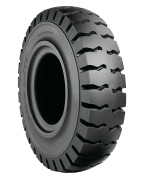Choosing the Right Forklift Tire
Tire selection is vital to lift truck operation. Demanding applications require the proper tire for a forklift's reliable performance. How do you choose the right tire? What tread and compound do you need?
Let me share some information about 2 types of forklift tires: Cushion Type and Pneumatic/Solid Type.
CUSHION TYPE TIRES
Cushion Tread
 The rule of thumb is:
The rule of thumb is:
Steer Tires - Always use a smooth tread.
Drive Tires - Use smooth tread when possible.
Smooth tire tread is the choice for most applications because smooth treads:
- Contain more rubber, for a longer service life
- Have a flat profile for greater stability
- Give a larger footprint for better traction
- Provide more effective cushioning, making a safer ride
- Resists cutting and chunking
If that's true, why do new lift trucks ship with traction tread?
Traction tread tires are installed by most manufacturers because they:
- Cost less to OEMs
- Are perceived to provide better traction
- Look rugged and dependable
Cushion Compound
Cushion tires are not just "black and round". Physical properties may be published by manufacturers. If they aren't published, a tire manufacturer can use lower cost rubber and additives for a cheaper and inconsistent product. Only MITL publishes specific physical properties.
There are two types of compound:
1. Universal Compound
- Designed for basic forklift cushion tires
- Formulated with standard quality rubber and additives
- Priced competitively
- Few problems in low- to medium-use applications
- Resists abrasion
2. Electric Compound (The best cushion tire to buy!)
- Lower rolling resistance o Formulated with high quality rubber and additives
- Runs cooler
- Resists tearing and chunking due to higher elongation
- Constructed of a softer material, protecting the equipment, operator, and load
PNEUMATIC/SOLID TYPE TIRES
With pneumatic tires, you have 3 choices on which type to use.
1. Softuff Solid Pneumatic
 Long wearing, scuff-resistant tread
Long wearing, scuff-resistant tread- Cushion-rubber center reduces load damage
- Steel reinforced base provides absolute rim adherence
- Greater ground clearance
- Diameter meets/exceeds global size and safety standards
- Zero-maintenance solid tire
- Concave sidewalls increase deflection, reducing equipment and driver fatigue
2. Softstandard
- Long wear, greater ground clearance and increased stability
- Constructed with a 70/30 rubber-to-friction stock ratio
- Precision interference fit helps eliminate spinning
- Rugged tread design provides maximum traction on all surfaces
- Concave sidewall improves shock absorption
3. MPC Type - Black and Round
Very popular because of its price
- European-type size which has less tread
- Soft riding center compound increases shock absorption
- Provides an economical solution for good tires
Ask Cromer what tire works best for your application. We're happy to help!


